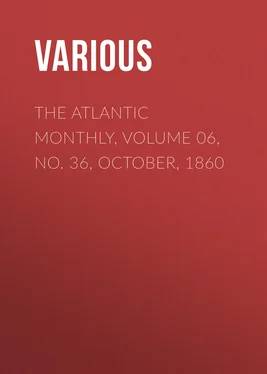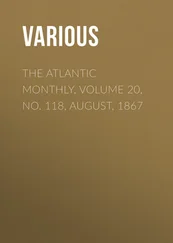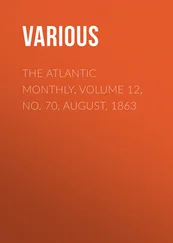Various - The Atlantic Monthly, Volume 06, No. 36, October, 1860
Здесь есть возможность читать онлайн «Various - The Atlantic Monthly, Volume 06, No. 36, October, 1860» — ознакомительный отрывок электронной книги совершенно бесплатно, а после прочтения отрывка купить полную версию. В некоторых случаях можно слушать аудио, скачать через торрент в формате fb2 и присутствует краткое содержание. Жанр: foreign_antique, periodic, foreign_edu, на английском языке. Описание произведения, (предисловие) а так же отзывы посетителей доступны на портале библиотеки ЛибКат.
- Название:The Atlantic Monthly, Volume 06, No. 36, October, 1860
- Автор:
- Жанр:
- Год:неизвестен
- ISBN:нет данных
- Рейтинг книги:3 / 5. Голосов: 1
-
Избранное:Добавить в избранное
- Отзывы:
-
Ваша оценка:
- 60
- 1
- 2
- 3
- 4
- 5
The Atlantic Monthly, Volume 06, No. 36, October, 1860: краткое содержание, описание и аннотация
Предлагаем к чтению аннотацию, описание, краткое содержание или предисловие (зависит от того, что написал сам автор книги «The Atlantic Monthly, Volume 06, No. 36, October, 1860»). Если вы не нашли необходимую информацию о книге — напишите в комментариях, мы постараемся отыскать её.
The Atlantic Monthly, Volume 06, No. 36, October, 1860 — читать онлайн ознакомительный отрывок
Ниже представлен текст книги, разбитый по страницам. Система сохранения места последней прочитанной страницы, позволяет с удобством читать онлайн бесплатно книгу «The Atlantic Monthly, Volume 06, No. 36, October, 1860», без необходимости каждый раз заново искать на чём Вы остановились. Поставьте закладку, и сможете в любой момент перейти на страницу, на которой закончили чтение.
Интервал:
Закладка:
When we had waited a good while, the old gardener came, telling us that he had heard an excellent prayer at laying the corner-stone of the new kirk. He now gave us some roses and sweetbrier, and let us out from his pleasant garden. We immediately hastened to Kirk Alloway, which is within two or three minutes' walk of the monument. A few steps ascend from the road-side, through a gate, into the old graveyard, in the midst of which stands the kirk. The edifice is wholly roofless, but the side-walls and gable-ends are quite entire, though portions of them are evidently modern restorations. Never was there a plainer little church, or one with smaller architectural pretension; no New England meeting-house has more simplicity in its very self, though poetry and fun have clambered and clustered so wildly over Kirk Alloway that it is difficult to see it as it actually exists. By-the-by, I do not understand why Satan and an assembly of witches should hold their revels within a consecrated precinct; but the weird scene has so established itself in the world's imaginative faith that it must be accepted as an authentic incident, in spite of rule and reason to the contrary. Possibly, some carnal minister, some priest of pious aspect and hidden infidelity, had dispelled the consecration of the holy edifice by his pretence of prayer, and thus made it the resort of unhappy ghosts and sorcerers and devils.
The interior of the kirk, even now, is applied to quite as impertinent a purpose as when Satan and the witches used it as a dancing-hall; for it is divided in the midst by a wall of stone-masonry, and each compartment has been converted into a family burial-place. The name on one of the monuments is Crawfurd; the other bore no inscription. It is impossible not to feel that these good people, whoever they may be, had no business to thrust their prosaic bones into a spot that belongs to the world, and where their presence jars with the emotions, be they sad or gay, which the pilgrim brings thither. They shut us out from our own precincts, too,—from that inalienable possession which Burns bestowed in free gift upon mankind, by taking it from the actual earth and annexing it to the domain of imagination. And here these wretched squatters have lain down to their long sleep, after barring each of the two doorways of the kirk with an iron grate! May their rest be troubled, till they rise and let us in!
Kirk Alloway is inconceivably small, considering how large a space it fills in our imagination before we see it. I paced its length, outside of the wall, and found it only seventeen of my paces, and not more than ten of them in breadth. There seem to have been but very few windows, all of which, if I rightly remember, are now blocked up with mason-work of stone. One mullioned window, tall and narrow, in the eastern gable, might have been seen by Tam O'Shanter, blazing with devilish light, as he approached along the road from Ayr; and there is a small and square one, on the side nearest the road, into which he might have peered, as he sat on horseback. Indeed, I could easily have looked through it, standing on the ground, had not the opening been walled up. There is an odd kind of belfry at the peak of one of the gables, with the small bell still hanging in it. And this is all that I remember of Kirk Alloway, except that the stones of its material are gray and irregular.
The road from Ayr passes Alloway Kirk, and crosses the Doon by a modern bridge, without swerving much from a straight line. To reach the old bridge, it appears to have made a bend, shortly after passing the kirk, and then to have turned sharply towards the river. The new bridge is within a minute's walk of the monument; and we went thither, and leaned over its parapet to admire the beautiful Doon, flowing wildly and sweetly between its deep and wooded banks. I never saw a lovelier scene; although this might have been even lovelier, if a kindly sun had shone upon it. The ivy-grown, ancient bridge, with its high arch, through which we had a picture of the river and the green banks beyond, was absolutely the most picturesque object, in a quiet and gentle way, that ever blessed my eyes. Bonny Doon, with its wooded banks, and the boughs dipping into the water! The memory of them, at this moment, affects me like the song of birds, and Burns crooning some verses, simple and wild, in accordance with their native melody.
It was impossible to depart without crossing the very bridge of Tam's adventure; so we went thither, over a now disused portion of the road, and, standing on the centre of the arch, gathered some ivy-leaves from that sacred spot. This done, we returned as speedily as might be to Ayr, whence, taking the rail, we soon beheld Ailsa Craig rising like a pyramid out of the sea. Drawing nearer to Glasgow, Ben Lomond hove in sight, with a dome-like summit, supported by a shoulder on each side. But a man is better than a mountain; and we had been holding intercourse, if not with the reality, at least with the stalwart ghost of one, amid the scenes where he lived and sung. We shall appreciate him better as a poet, hereafter; for there is no writer whose life, as a man, has so much to do with his fame, and throws such a necessary light upon whatever he has produced. Henceforth, there will be a personal warmth for us in everything that he wrote; and, like his countrymen, we shall know him in a kind of personal way, as if we had shaken hands with him, and felt the thrill of his actual voice.
At an angle of the palace which Pius VI., (Braschi,) with paternal liberality, built for the residence of his family, before the French Revolution put an end to such beneficence, stands the famous statue of Pasquin, giving its name to the square upon which it looks. It is little more now than a mere trunk of marble, bearing the marks of blows and long hard usage. But even in this mutilated condition it shows traces of excellent workmanship and of pristine beauty. The connoisseurs in sculpture praise it, 1 1 Bernini, being asked what was the most beautiful statue in Rome, replied, "That of Pasquin." This reply the sensible Milizia taxes with affectation,—saying, that, although an artist may discover in the work some marks of good design, it is now too maimed to pass for a beautiful statue. Possibly Bernini was thinking of his own works in comparison with it.
and the antiquaries have embittered their ignorance in regard to it by discussions as to whether it was a statue of Hercules, of Alexander the Great, or of Menelaus bearing the body of Patroclus. Disabled and maimed as it is, it is thus only the more fitting type of the Roman people, of which it has been so long the acknowledged mouthpiece; and the epigrams and satires which have made its name famous have gained an additional point and a sharper sting from the patent resemblance in the condition of their professed author to that of those for whom he spoke.
It is said to have been about the beginning of the sixteenth century that the statue was discovered and dug up near the place where it now stands, and the earliest account of it seems to be that given by Castelvetro, in 1553, in his discourse upon a canzone by Annibal Caro. He says, that Antonio Tibaldeo of Ferrara, a venerable and lettered man, relates concerning this statue, that there used to be in Rome a tailor, very skilful in his trade, by the name of Pasquin, who had a shop which was much frequented by prelates, courtiers, and other people, so that he employed a great number of workmen, who, like worthless fellows, spent their time in speaking ill of one person or another, sparing no one, and finding opportunity for jests in observing those who came to the shop. This custom became so notorious that the very persons who were hit by these sharp speeches joined in the laugh at them, and felt no resentment; so that, if any one wished to say a hard thing of another, he did it under cover of the person of Master Pasquin, pretending that he had heard it said at his shop,—at which pretence every one laughed, and no one bore a grudge. But, Master Pasquin dying, it happened, that, in improving the street, this broken statue, which lay half imbedded in the ground, serving as a stepping-stone for passengers, was taken up and set at the side of the shop. Making use of this good chance, satirical people began to say that Master Pasquin had come back. The custom soon arose of attaching to the statue bits of writing; and as it had been allowed to the tailor to say everything, so by means of the statue any one might publish what he would not have ventured to speak. 2 2 Andreas Schott,—who published an Itinerary of Italy about the beginning of the seventeenth century, copies this account, and adds,—"At present this custom is prohibited under the heaviest penalties."
Интервал:
Закладка:
Похожие книги на «The Atlantic Monthly, Volume 06, No. 36, October, 1860»
Представляем Вашему вниманию похожие книги на «The Atlantic Monthly, Volume 06, No. 36, October, 1860» списком для выбора. Мы отобрали схожую по названию и смыслу литературу в надежде предоставить читателям больше вариантов отыскать новые, интересные, ещё непрочитанные произведения.
Обсуждение, отзывы о книге «The Atlantic Monthly, Volume 06, No. 36, October, 1860» и просто собственные мнения читателей. Оставьте ваши комментарии, напишите, что Вы думаете о произведении, его смысле или главных героях. Укажите что конкретно понравилось, а что нет, и почему Вы так считаете.












